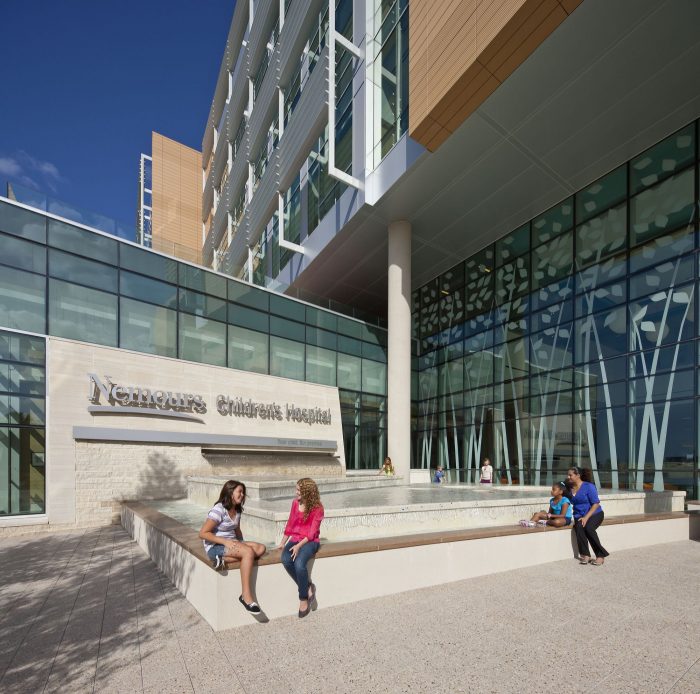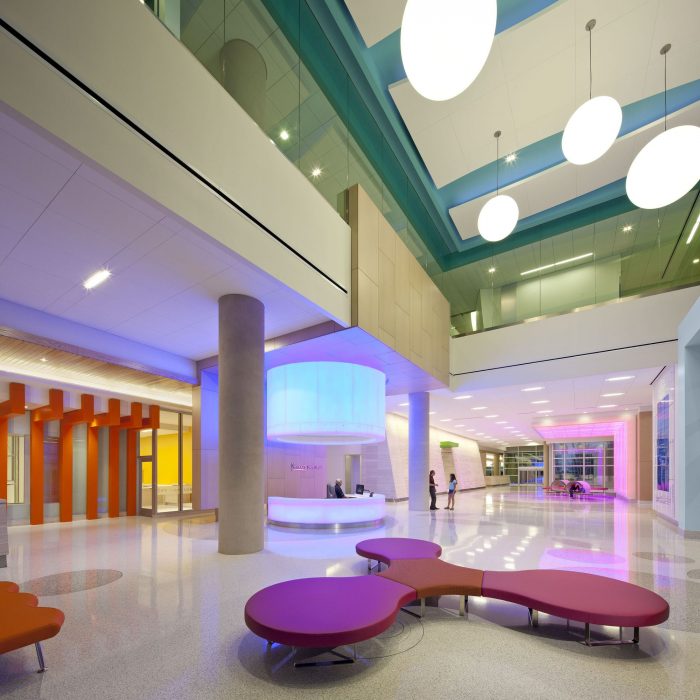Nemours Children’s Hospital, situated in the Lake Nona Medical City mixed-use development in Orlando, Florida, has set a new design standard. Led by architect Stanley Beaman & Sears, the new hospital and grounds are a testament to the term “healing environment” – evoking a life-affirming quality sure to reassure parents and delight children. The project’s architectural solution arose out of a collaboration with Nemours’ many stakeholders, including practitioners, administrators, and a family advisory committee of parents and children.
The Nemours children’s hospital’s philosophy is one that embraces children “across the continuum”: from infancy to adulthood, Nemours cares for children with chronic conditions, as well as complex medical diagnoses and life-threatening illnesses. The children’s hospital campus is designed to both reassure and inspire, engage and delight – and the investment in a landscape, in particular, reflects Nemours’ understanding of the role nature plays in the life of a child. During the planning process, when core questions arose, the design team was inspired by how often the Nemours leadership asked simply, “What’s in the best interest of the child?” – cutting through debate and getting to the heart of their priorities as an organization.
The hospital’s family-centered care philosophy led to strategies aimed at supporting families from all walks of life: patient rooms with overnight accommodations for two parents, laundry facilities, and a concierge desk in the elevator lobby of each floor to help parents navigate a sometimes intimidating healthcare system. Ample lounges and playrooms overlook and give access to extensive outdoor spaces designed for respite and recreation. These include landscaped rooftop terraces, interactive water features, a “discovery garden” and an outdoor community event stage for live performances.
The project’s 630,000-square-foot, $260-million facility includes a landscaped entry court, 95 inpatient beds and 76 exam rooms, emergency facilities, a central energy plant and a parking deck. Shell space can accommodate another 32 beds and 24 exam rooms. The master plan anticipates expansion of inpatient and outpatient spaces, as well as additional medical offices, research, and support facilities. The palette of exterior materials includes precast, terracotta, metal panels, patterned glass and curtain wall systems. A combination of specialty finishes and high-performance materials give the interiors a clean, modern aesthetic, and colorful furniture and wayfinding graphics punctuate spaces throughout. The color of patient room accent lighting can be selected by the child, creating an ever-changing dynamic on the building’s façade – an artful reminder of the children being cared for at Nemours.
In Orlando’s subtropical environment, intense sun and humidity were a major design concern. Extensive solar studies resulted in shaded outdoor spaces and also helped determine the design and placement of sunscreens – blocking direct sunlight while admitting abundant natural light to the interiors. In response to the area’s high water table, the architects designed a curving ramp to raise the entry drive one level, allowing a daylight basement that accommodates the facility’s delivery and service functions. This gesture also serves as a major landscape feature that continues through the building and beyond, where it skirts alongside outdoor garden rooms, concluding in another landscaped destination. Both function and feature, the honey-colored stone wall is also a wayfinding device, giving a hierarchy to the site and leading to and from main entries. Most notable, from a functional standpoint, is the alignment of outpatient and inpatient care. Outpatient clinics and inpatient rooms devoted to a particular medical specialty are located in adjacent wings of the same floor, enabling a consistent care team to become familiar to children and their families during both clinic visits and inpatient stays. The Nemours Children’s Hospital is a “smart” building in many ways: A “command center” monitors an array of clinical and facility-related metrics, the technology integration is both functional and fun, and the sustainability goal is reaping far more rewards than just energy savings.
The Nemours Children’s Hospital is one of only three Children’s Hospitals in the nation to achieve LEED Gold Certification with Stanley Beaman & Sears having designed two of the three. The design team was fortunate to have a client, in Nemours, who cared deeply about sustainability and who understood the tangible return on that investment in both future energy savings but also environmental quality. Because the 60-acre greenfield site initially had very little vegetation, Nemours put a priority on landscaping, encouraging planting early in the construction process, so that a mature landscape could be created by opening day. The interior spaces are flooded with natural light and views of nature are abundant for children and families, as well as for staff and support personnel. While the design of facilities for children can easily resort to gimmick or cliché, this Children’s Hospital design avoids that tendency entirely, striking a more authentic tone: a mature yet lively architecture, an enriching and fresh interior atmosphere, and a site design that celebrates the role nature can play in the healing process.
Project Info:
Architects: Stanley Beaman & Sears
Location: Orlando, FL, USA
Area: 630000.0 ft2
Project Year: 2012
Photographs: Jonathan Hillyer
Manufacturers: Shildan
Products: Terracotta Rainscreen Facade System – LONGOTON®
Project Name: Nemours Children’s Hospital




